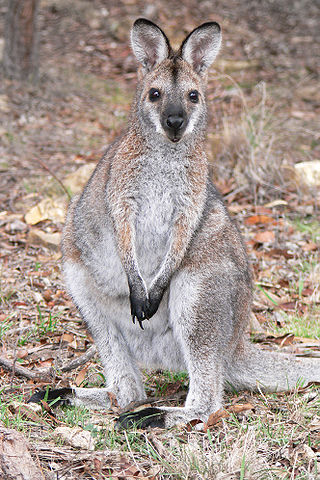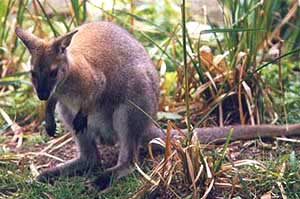
Phalangeriformes is a paraphyletic suborder of about 70 species of small to medium-sized arboreal marsupials native to Australia, New Guinea, and Sulawesi. The species are commonly known as possums, gliders, and cuscus. The common name "possum" for various Phalangeriformes species derives from the creatures' resemblance to the opossums of the Americas. However, although opossums are also marsupials, Australasian possums are more closely related to other Australasian marsupials such as kangaroos.

Charadriiformes is a diverse order of small to medium-large birds. It includes about 390 species and has members in all parts of the world. Most charadriiform birds live near water and eat invertebrates or other small animals; however, some are pelagic (seabirds), others frequent deserts, and a few are found in dense forest. Members of this group can also collectively be referred to as shorebirds.

Tree-kangaroos are marsupials of the genus Dendrolagus, adapted for arboreal locomotion. They inhabit the tropical rainforests of New Guinea and far northeastern Queensland, along with some of the islands in the region. All tree-kangaroos are considered threatened due to hunting and habitat destruction. They are the only true arboreal macropods.

Macropodidae is a family of marsupials that includes kangaroos, wallabies, tree-kangaroos, wallaroos, pademelons, quokkas, and several other groups. These genera are allied to the suborder Macropodiformes, containing other macropods, and are native to the Australian continent, New Guinea and nearby islands.

The banded hare-wallaby, mernine, or munning is a marsupial currently found on the islands of Bernier and Dorre off western Australia. Reintroduced populations have recently been established on islands and fenced mainland sites, including Faure Island and Wadderin Sanctuary near Narembeen in the central wheatbelt.

The term Australian megafauna refers to the megafauna in Australia during the Pleistocene Epoch. Most of these species became extinct during the latter half of the Pleistocene, and the roles of human and climatic factors in their extinction are contested.

Atriplex is a plant genus of about 250 species, known by the common names of saltbush and orache. It belongs to the subfamily Chenopodioideae of the family Amaranthaceae s.l.. The genus is quite variable and widely distributed. It includes many desert and seashore plants and halophytes, as well as plants of moist environments. The generic name originated in Latin and was applied by Pliny the Elder to the edible oraches. The name saltbush derives from the fact that the plants retain salt in their leaves; they are able to grow in areas affected by soil salination.

Procoptodon is an extinct genus of giant short-faced (sthenurine) kangaroos that lived in Australia during the Pleistocene Epoch. P. goliah, the largest known kangaroo species that ever existed, stood at about 2 m (6.6 ft). They weighed about 200–240 kg (440–530 lb). Other members of the genus were smaller, however; Procoptodon gilli was the smallest of all of the sthenurine kangaroos, standing approximately 1 m tall.

Sthenurinae is a subfamily within the marsupial family Macropodidae, known as 'short faced kangaroos'. No members of this subfamily are extant today, with all becoming extinct by the late Pleistocene. Procoptodon goliah, the largest macropodid known to have existed, was a sthenurine kangaroo, but sthenurines occurred in a range of sizes, with Procoptodon gilli being the smallest at the size of a small wallaby.

Sthenurus is an extinct genus of kangaroos. With a length around 3 m (10 ft), some species were twice as large as modern extant species. Sthenurus was related to the better-known Procoptodon. The subfamily Sthenurinae is believed to have separated from its sister taxon, the Macropodinae, halfway through the Miocene, and then its population grew during the Pliocene.

The Macropodiformes, also known as macropods, are one of the three suborders of the large marsupial order Diprotodontia. They may in fact be nested within one of the suborders, Phalangeriformes. Kangaroos, wallabies and allies, bettongs, potoroos and rat kangaroos are all members of this suborder.

Rhytididae is a taxonomic family of medium-sized predatory air-breathing land snails, carnivorous terrestrial pulmonate gastropod molluscs in the superfamily Rhytidoidea.

Protemnodon is an extinct genus of megafaunal macropodids that existed in Australia, Tasmania, and New Guinea in the Pliocene and Pleistocene. Members of this genus are also called giant kangaroos.

Simosthenurus, also referred to as the short-faced kangaroo, is an extinct genus of megafaunal macropods that existed in Australia, specifically Tasmania, during the Pleistocene. Analysis of Simosthenurus fossils has contributed to the finding that there are three lineages of macropods: Sthenurinae, Macropodinae, and Lagostrophinae. The genus Simosthenurus was among the sthenurines.

A cusp is a pointed, projecting, or elevated feature. In animals, it is usually used to refer to raised points on the crowns of teeth. The concept is also used with regard to the leaflets of the four heart valves. The mitral valve, which has two cusps, is also known as the bicuspid valve, and the tricuspid valve has three cusps.

Julian Pender Hume is an English palaeontologist, artist and writer who lives in Wickham, Hampshire. He was born in Ashford, Kent, and grew up in Portsmouth, England.

James Lloyd Patton, is an American evolutionary biologist and mammalogist. He is emeritus professor of integrative biology and curator of mammals at the Museum of Vertebrate Zoology, UC Berkeley and has made extensive contributions to the systematics and biogeography of several vertebrate taxa, especially small mammals.

Simosthenurus occidentalis is a species of sthenurine marsupial that existed in Australia during the Pliocene, becoming extinct in the Pleistocene epoch around 42 000 years ago. A large herbivorous biped that resembles large kangaroos, the species had a heavier body than the modern roo. The structure of the skull and teeth indicates it consumed tough vegetation, resembling koalas and panda bears, and is referred to as a short-faced kangaroo.
Nombe is an extinct genus of macropodid containing a single species, Nombe nombe. which was formerly classified as a member of the genus Protemnodon. It was native to New Guinea during the Late Pleistocene. It was relatively large in body size and is thought to have been a browser. Phylogenetic analysis suggests that it is a basal member of the subfamily Macropodinae.

Congruus is an extinct genus of macropod known from the Late Pleistocene of Australia. There are two species, Congruus kitcheneri, which was originally described as a species of Wallabia, and Congruus congruus. Specimens are known from Mammoth Cave, Western Australia, the Thylacoleo Caves and the Naracoorte caves in South Australia. Potential material is also known from Eastern Australia. The morphology of the skull and limbs suggests that they were semi-arboreal browsers, moving slowly through trees, though they were larger than and not as specialised for climbing as living tree kangaroos. They are thought to be members of the tribe Macropodini, and close relatives of the extinct genus Protemnodon.





















